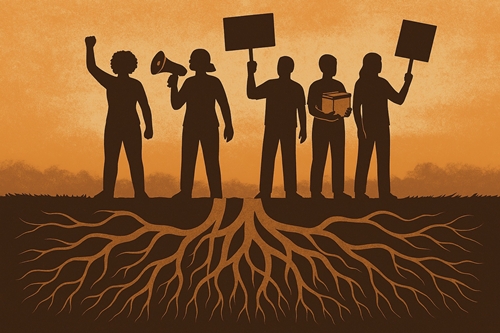Building from Below: A Defiant Guide to Grassroots Resistance
Autocratic regimes don’t fall because a single leader decides to relinquish power. They fall when people, ordinary, determined, and deeply rooted in community, stand up and refuse to be silent. When power is hoarded from the top, resistance must rise from the bottom.
Grassroots resistance is that uprising in slow motion. It builds beneath the surface until the ground shifts. But movements that endure don’t happen by accident. They are built intentionally, strategically, and with unrelenting clarity of purpose.
If you’re asking how to build a grassroots movement, not just rally a crowd or run a campaign, but forge a collective force that reshapes the terrain, you’re already thinking like a movement-maker. Here’s how to start.
Building the Foundation: Start Where You Are, With What You Have
Start with People, Not Petitions
Movements aren’t born on websites or in notebooks. They emerge from living rooms, parks, hardware stores, mutual aid groups, and school boards. Grassroots power begins with relationships built on trust, care, and shared struggle.
Activities to build structure:
- Listening Circles & Story Exchanges
Example: The Women’s March began with thousands of “huddles” across the U.S. to surface local priorities before launching national actions. These gatherings helped shape a decentralized but unified agenda rooted in lived experience. - Neighborhood Affinity Groups
Example: During the COVID-19 pandemic, mutual aid pods formed by neighborhood or need (e.g., food delivery, childcare) became the backbone of broader resistance networks. These pods later evolved into eviction defense teams and community safety collectives. - Skill-Sharing Workshops
Example: In Hong Kong, pro-democracy activists distributed encrypted digital playbooks to train everyday citizens in organizing flash mobs, digital security, and evading surveillance, empowering decentralized action under authoritarian pressure.
Defining Objectives: Strategy Beats Slogan
A movement without direction risks becoming an echo chamber of frustration. Clear, concise goals galvanize people.
From Outrage to Strategy:
- Apply the SMART Objective Framework
Example: Instead of “fight environmental racism,” a SMART objective might be: “Pressure City Council to pass Resolution 22 banning asphalt plants near schools by November.” - Use Power Mapping
Example: Indivisible groups used power mapping to identify key congressional targets and then organized town halls, media campaigns, and constituent pressure to influence votes on healthcare and immigration. - Co-Create, Don’t Dictate
Example: The Poor People’s Campaign developed its national demands through listening sessions with impacted communities from Appalachia to Skid Row, ensuring the agenda reflected lived realities.
Planning for Impact: Tactics Are the Translation of Vision
You’ve got clarity, now what do you do with it? Strategy turns into momentum when broken into campaigns. And campaigns are composed of tactics, each one a lever on the system you’re trying to bend.
Blueprints for Bold Action:
- Tactic Selection Matrix
Example: The RE-AMP Grassroots Tactics Guide helps organizers evaluate tactics like teach-ins, banner drops, civil disobedience, and shareholder activism based on risk, visibility, and impact. - 90-Day Campaign Sprints
Example: The Sunrise Movement’s Green New Deal Tour was a time-bound campaign with clear deliverables: over 200 town halls, media hits, and policy pledges, all within six weeks. - Feedback Loops
Example: After the 2017 airport protests, resistance hubs created Slack groups to rapidly share tactics across cities, refining playbooks that had been improvised in the moment.
Scaling Up Without Selling Out
Once your movement gains traction, the risk shifts: dilution, co-optation, or burnout can creep in. The way to sustain resistance is by decentralizing power and doubling down on values.
Sustainability as Strategy:
- Shared Leadership Models
Example: Black Lives Matter Grassroots operates as a constellation of autonomous chapters grounded in a common vision, not a rigid central authority. This structure fuels resilience and adaptability. - Narrative Power
Example: The Dreamers movement used personal storytelling to shift public opinion and policy on immigration. By refusing to stay silent, undocumented youth reframed the national conversation. - Embed Mutual Aid
Example: Mutual Aid Disaster Relief in Puerto Rico turned disaster response into resistance, providing food, shelter, and medical care while building long-term community infrastructure in the face of colonial neglect.
Resources: Tools for Building Grassroots Power
Organizing & Strategy
Indivisible Guide: Tactical guide for local advocacy and congressional pressure.
RE-AMP Grassroots Tactics Guide: Framework for evaluating and selecting campaign tactics.
Beautiful Trouble: A toolbox of creative activism tactics and case studies.
Training & Mutual Aid
Mutual Aid Disaster Relief: Resources for building mutual aid infrastructure in times of crisis.
The Frontline: Training and mobilization hub for progressive grassroots action.
Resist.org: Grantmaking and support for frontline-led grassroots movements.
Narrative & Messaging
The Center for Story-Based Strategy: Tools for crafting narratives that shift power
RadComms: A network for strategic communicators in social justice movements.
Final Word: Your Defiance Is the Blueprint
Grassroots resistance is messy. It’s slow. It’s made of spreadsheets, late-night phone calls, and people showing up when it’s inconvenient. But it’s also ferocious. It changes laws, flips elections, protects communities, and topples tyrants.
And right now, it’s not optional.
As Trump escalates his assault on democratic norms, gutting environmental protections, silencing dissent, and dismantling public institutions, we cannot afford to wait for permission or perfect conditions. We need a whole-of-society response to a whole-of-government attack.
So start where you are. Build what you need. Join a local assembly. Launch a mutual aid pod. Organize a teach-in. Pressure your city council. Flood the phone lines. Protect your neighbors. Tell your story. And never apologize for demanding the impossible because history is made by those who refuse to settle for less.
This is not a drill. This is the blueprint. And you are already part of it. So get out there and make history!
